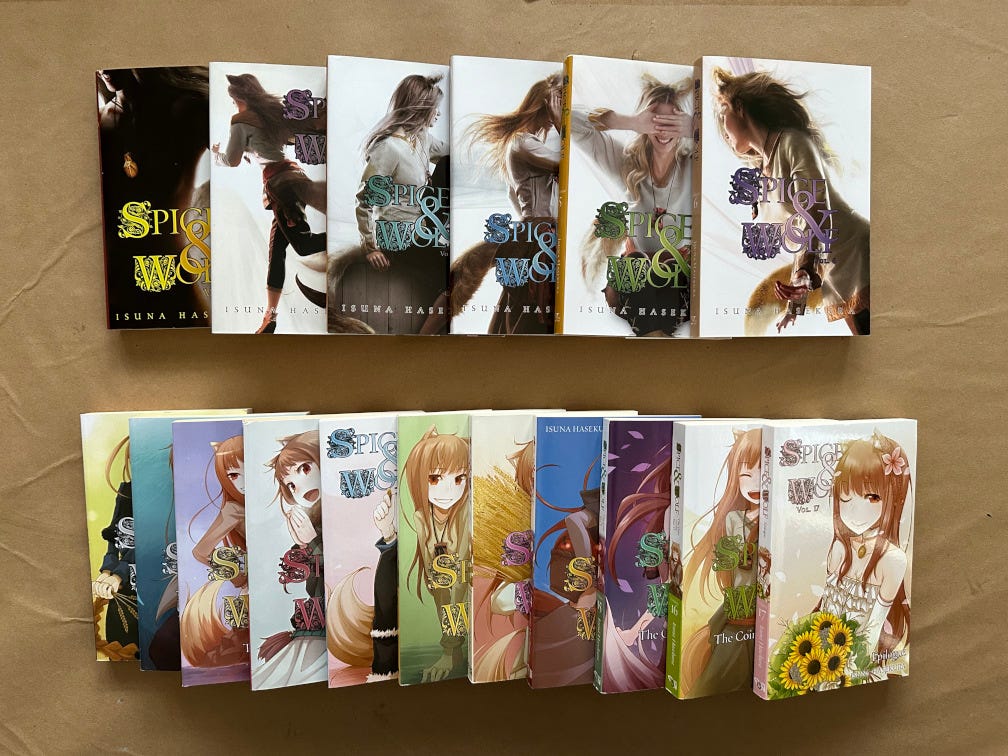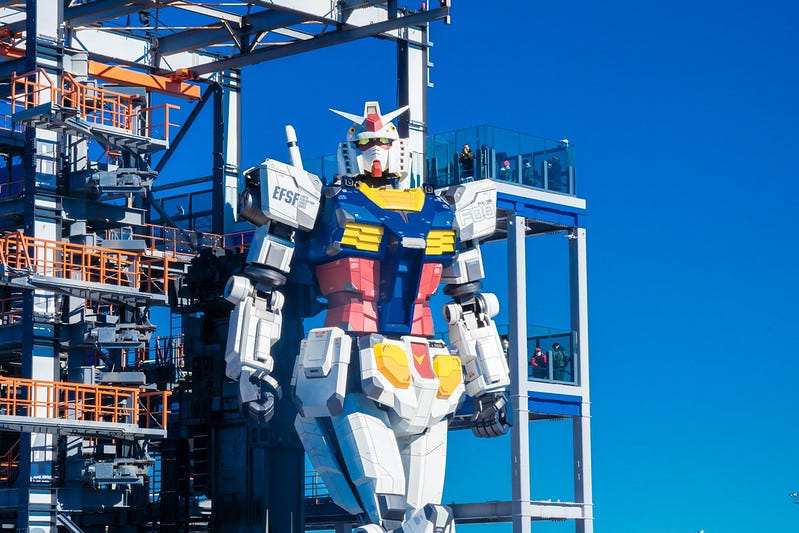Anime worker survey: Long hours, low pay
Plus: 'Spice and Wolf' returns as light novels rise globally; Life-size Gundam robot ends exhibition run; How anime license revenues diversify from home video; and more
This is your weekly Animenomics briefing, covering the business of anime and manga. Today is Wednesday, April 3, 2024.
In case you missed it: Funimation, the Dallas, Tex.-based anime brand that began in 1994, was discontinued and merged into Crunchyroll yesterday. Its operator, a subsidiary of Sony, acquired the Crunchyroll streaming service in 2021.
Read past coverage by the Dallas Observer and Dallas Innovates on Funimation’s influence on North America’s anime market.
Long hours, low pay hinder teaching of young workers
Ultra-long working hours and persistently low income are disrupting the anime industry’s tradition of studio veterans passing on knowledge to rookie animators, a new survey by the Nippon Anime & Film Culture Association (NAFCA) finds.
Why it matters: Anime production relies heavily on technical knowledge passed down from one animator to the next to ensure consistent quality.
By the numbers: Among the survey’s 323 respondents, the average number of hours worked per month is 219 hours, 34 percent higher than Japan’s national average of 163.5 hours per month, according to the Nikkei financial newspaper.
Based on reported income and working hours, the median hourly rate of pay was ¥1,111 (US$7.33). This is slightly lower than the minimum wage of ¥1,113 (US$7.34) in Tokyo, where 85 percent of anime studios are located.
Zoom in: Respondents under the age of 30 who learned their trade through self-study or in a classroom setting far outnumber those who learned on the job from their coworkers, while the reverse is true for older age groups.
“The time and energy to teach others is being depleted,” the report’s authors write.
Yes, but: A different set of surveys conducted by the Japan Animation Creators Association (JAniCA) found that working hours in the anime industry have been on the decline since the 2000s.
JAniCA found that the average number of hours worked per month was 273 hours in 2008, 263 hours in 2013, 231 hours in 2017, and 198 hours in 2021.
JAniCA’s surveys also show that the average annual income and the number of days off received by anime workers have risen over the same period.
The bigger picture: Low income remains an issue. Two out of three companies in television and anime production and publishing that were surveyed by Tokyo Shoko Research in December said that they had no plans to raise wages in 2024.
‘Spice and Wolf’ anime bookend light novels’ global rise

A new Spice and Wolf anime airing this month is entering public discourse at a time when the global anime market is much friendlier to works adapted from the prose-forward light novel publishing format than it was two decades ago.
Why it matters: Japan’s light novel market climbed to an estimated ¥54.5 billion (US$362 million) in 2022, more than triple its size in the early 2000s.
The last time a Spice and Wolf anime aired, in 2008 and 2009, few publishers outside East Asia were actively licensing and selling light novels.
Rewind: Manga publisher Yen Press is North America’s light novel market leader, but when it launched Spice and Wolf as its first light novel license 15 years ago, retail partners asked the publisher to change the books’ original cover art.
“The unfortunate reality we face, though, is that these designs that we adore, while they work brilliantly in markets where manga is ubiquitous, tend not to be impactful with more general audiences,” the publisher explained in 2009.
After receiving swift rebuke from anime and manga fans on the decision, the publisher settled on a compromise that preserved the original cover art while adding a redesigned dust jacket to appease retailers.
“A lot has changed in the last 14–15 years in the world of light novels in English. Today’s publishers of light novels, including Yen On, have found it best to retain the original cover designs from Japan,” a Yen Press spokesperson told Animenomics in an emailed statement.
What’s happening: Most manga publishers in North America today have added light novels, especially ones that have the best potential to be adapted into anime, to supplement their catalogs.
“The rise in sales typically happens during or after an anime’s serialization,” the Yen Press spokesperson told Animenomics, anticipating that the Spice and Wolf anime will bring renewed interest in the original light novels.
Clippings: Gundam Factory Yokohama ends operation

Gundam Factory Yokohama’s moveable life-size Gundam robot model drew more than 1.75 million visitors over three plus years. The exhibition, a commemoration of the Mobile Suit Gundam anime’s 40th anniversary, ended Sunday. (The Mainichi)
Reality check: Despite the exhibition’s popularity, operator Evolving G, a Bandai Namco Holdings subsidiary, had lost ¥3.7 billion (US$24 million) since the beginning of the project as of March 2023.
Japanese live-action and anime titles were the third most-watched category of non-English content on Netflix in 2023. To meet the demand, private broadcaster TBS has built a ¥2 billion (US$13 million) live-action production studio. (Nikkei)
The studio, operating under a new TBS subsidiary The Seven, also recruited Akira Morii, who produced the acclaimed live-action adaptation of Shogakukan’s Alice in Borderland manga.
Online manga piracy cost publishers ¥382 billion (US$2.5 billion) in unrealized revenue in 2023, a 68-percent decline since the COVID-19 pandemic peak in 2021, according to ABJ, an association of stakeholders in Japan’s publishing industry. (Agency for Cultural Affairs)
AMC Networks-owned HIDIVE has increased the subscription price of its anime streaming service from US$4.99 to US$5.99 a month, weeks after the service launched a new website and interface for its supported devices. (HIDIVE Support)
How production companies diversify from home video
“[O]ngoing diversification makes it very difficult to decide on metrics for success. And there’s also the issue of discrepancies between a show’s actual performance numbers and its popular reputation, since those two things sometimes don’t match up. I think that ultimately, the important thing will be the show’s combined total sales numbers across all global revenue streams: online streaming, TV broadcast, home video sales, merchandise, events, etc.”
— Yuna Kishita, international license sales at Kadokawa
Context: Speaking with Anime Trending, Kishita explains how today’s anime production committees assess a work’s performance at a time when Blu-ray and DVD sales in Japan’s domestic home video market are in decline.
Kishita’s role is to help Kadokawa recoup the cost of anime production with license revenue from international sales.
“Most recently, for shows like Oshi no Ko and Delicious in Dungeon, we’ve created X (Twitter) accounts tailored to overseas fans,” says Kishita.
Between the lines: With consumers in Japan buying fewer Blu-rays and DVDs, manufacturers are also packaging anime titles into fewer home video releases.
An analysis by the Association of Japanese Animations found that the average number of Blu-ray volumes released for a given 13-episode anime series declined from 3.33 to 2.65 between 2019 and 2022.
By putting more episodes into a single release, manufacturers reduce the cost of package production and increase their profit margins.
Animenomics is an independently-run and reader-supported publication. If you enjoyed this newsletter, consider sharing it with others.



